Cubera Snapper
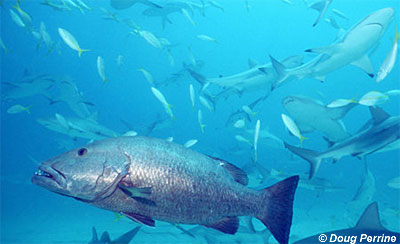
Lutjanus cyanopterus
These solitary reef fish are large, almond-shaped carnivores that average 3 feet long but can grow to 5 feet long. They are gray to dark brown, with a continuous dorsal fin, longish pectoral fins, and a long caudal peduncle (tail) ending in a stout caudal fin. They are very slender for fish in this family, but they do have the classic long snapper canine teeth that are visible even when their mouths are closed. They are a popular game fish but are vulnerable to over fishing during their spawning season.
Order: Perciformes
Family: Lutjanidae
Genus: Lutjanus
Species: cyanopterus
Common Names
English language common names include cubera snapper, canteen snapper, cuban snapper, and gray snapper. Other common names are caranha, vermelho-caranho and caranho (Portuguese); cuberta, pargo, pargo cabello, and pargo cubera (Spanish); schnapper (German); and vivaneau cubéra (French).
Importance to Humans
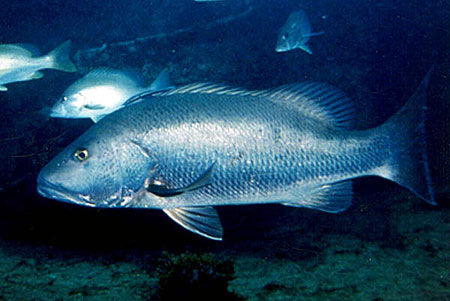
The cubera snapper is a popular game and food fish. There have been reports of ciguatera poisoning from specimens of this snapper. Ciguatera poisoning is caused by free swimming dinoflagellates or other algae on dead corals. Certain fishes eat these dinoflagellates and algae, and the snapper then feeds upon those fishes. The dinoflagellates and algae have toxins that build up in the predatory fish’s liver and flesh, and if it reaches a certain level, it can cause poisoning to humans who eat the snapper. Poisoned people report having gastrointestinal problems for up to years, and a general weakness in their arms and legs. It is very rare to be afflicted with ciguatera poisoning, but caution should be exercised when consuming large predatory fishes such as snappers, barracudas, and jacks in the tropics.
Conservation
The cubera snapper is considered “Vulnerable” by the International Union for Conservation of Nature and Natural Resources (IUCN). The IUCN is a global union of states, governmental agencies, and non-governmental organizations in a partnership that assesses the conservation status of species. Cubera snapper are particularly vulnerable to overfishing during their spawning activities off the coast of Florida and in the Caribbean Sea.
> Check the status of the cubera snapper at the IUCN website.
Geographical Distribution
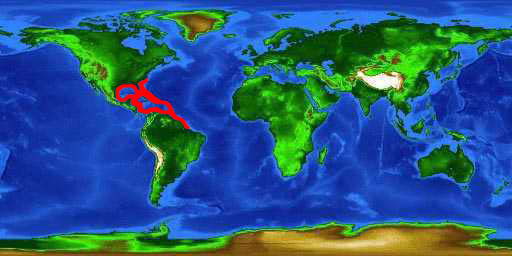
The cubera snapper ranges from Massachusetts to Brazil in the western Atlantic Ocean. It is a tropical species and is rare north of Florida and in the Gulf of Mexico.
Habitat
Cubera snappers are solitary reef dwellers. Living inshore or nearshore, they most often associate with ledges over rocky ledges and overhangs. They live at depths to 175 feet (55 meters) below the water surface. The young typically inhabit inshore mangrove areas and seagrass beds that offer some protection from predators. Small cubera also are known to enter estuaries, mangrove areas, and the tidal reaches of streams and freshwater canals.
Biology
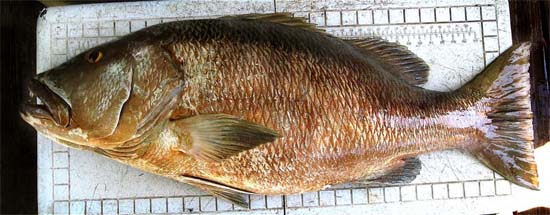
Distinctive Features
This snapper is slightly different than some of the others in the Lutjanidae family as it has an elongate, slender body that is not very deep. It is similar to other lutjanids in having a longish pectoral fin, and a continuous dorsal fin. The caudal fin is fairly truncate shaped. The mouth has thick lips and large teeth.
The cubera snapper is easily confused with the gray snapper (Lutjanus griseus). However, these two species can be distinguished from each other by the shape of the vomerine tooth patch at the top of the palate. The gray snapper has an anchor-shaped tooth patch while the cubera has a triangular-shaped patch.
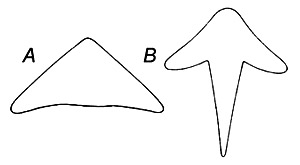
Coloration
These fish are generally gray or dark brown with pale to dark gray sides. There may also be a slight reddish tinge on the body. There is a bluish tinge on the anal and ventral fins. The caudal fin is a light gray in color while the pectoral fins are translucent or gray. Juveniles have a faintly barred pattern on either side that fades away as an adult.
Dentition
Cubera snapper have large mouth with thick lips. Both jaws contain canine teeth with one pair of canines large enough to be visible even when the mouth is closed. The vomerine teeth are arranged in a triangular shape on the top of the palate.
Common weighing around 40 pounds (18 kg) and reaching lengths of 3 feet (90 cm), the cubera snapper may reach up to 125 pounds (58 kg) and 5 feet (6 m) in length. This snapper is easily the largest snapper occurring in the Atlantic Ocean.
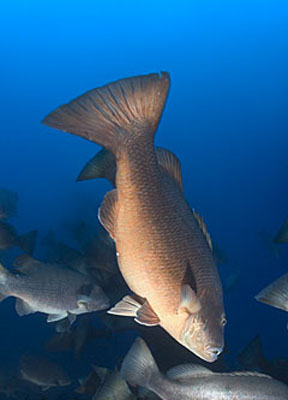
Food Habits
An aggressive, carnivorous fish, the cubera snapper feeds primarily on fishes and crabs. The strong canines allow mature cubera to feed on large crustaceans including lobsters and crabs. Feeding grounds are typically located near the bottom in rocky reef areas or adjacent to other structures.
Reproduction
All snappers are oviparous breeders, releasing pelagic eggs into offshore waters. The cubera snapper spawns from June to August in the waters in the Caribbean. During spawning, hundreds of individuals may aggregate over deep areas. The eggs hatch within a day after fertilization, producing pelagic larvae that are dispersed by the currents. There is little known about the development of the larvae and their settlement out of the plankton.
Predators
Whale sharks (Rhincodon typus) feed on freshly released cubera snapper spawn in waters off Belize in Central America. Predators of snappers are numerous and include sharks, barracuda, grouper, moray eels and other snapper species.
Taxonomy
Lutjanus cyanopterus was first described by Georges Cuvier in 1828 based on a Brazilian specimen. Although this fish only shows tinges of blue coloration, the Latin species name cyanopterus means blue fin. Synonyms appearing in past scientific literature referring to this species include Mesoprion pargus Cuvier, 1828, Lutjanus cubera Poey, 1871, and Lutjanus cynodon Poey, 1868.
Prepared by: Rebecca Murray and Cathleen Bester